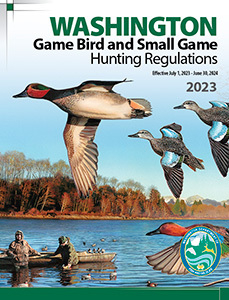Game Bird Baiting Regulations
The following information summarizes state and federal game bird baiting regulations, which have recently been standardized. Additional information about federal baiting regulations is described in the Summary of Federal Regulations below, at www.fws.gov/le/HuntFish/waterfowl_baiting.htm, or by calling (503) 231-6125.
What is baiting?
Baiting is the direct or indirect placing, exposing, depositing, distributing, or scattering of salt, grain, or other feed that could lure or attract game birds to, on, or over any areas where hunters are attempting to take them. A baited area is any area on which salt, grain, or other feed has been placed, exposed, deposited, distributed, or scattered, if that salt, grain, or feed could serve as a lure or attraction for game birds.
How long is an area baited?
A baited area remains off limits to hunting for 10 days after all salt, grain, or other feed has been completely removed.
How close to bait can you hunt without breaking the law?
There is no set distance. The law prohibits hunting if bait is present that could lure or attract birds to, on, or over areas where hunters are attempting to take them. Distance will vary depending on the circumstances and such factors as topography, weather, and flight patterns. Therefore, this question can only be answered on a case-by-case basis.
What is Illegal?
Examples of areas where you cannot hunt game birds include:
- Unharvested crops that have been trampled by livestock or subjected to manipulations that distribute, scatter, or expose grain.
- Areas where grain or seed has been top-sown and the Cooperative Extension Service does not recommend the practice of top sowing, including freshly planted wildlife food plots that contain exposed grain.
- Croplands where a crop has been harvested and the removed grain is redistributed or “added back” onto the area where grown.
- For waterfowl and coot hunting, areas where grain is present and stored, such as grain elevators, grain bins, and livestock feeding areas. Hunters are cautioned that hunting within the vicinity (zone of influence) of a grain elevator or other places where grain is stored or fed to livestock may subject them to prosecution for hunting with the aid of bait. For example, the grain elevators near the mouth of the Walla Walla River, mouth of the Snake River, Clarkston, Lyons Ferry and Kalama, to name a few, have received heavy hunting pressure in past years. These areas are considered baited areas because they have exposed grain not related to a normal agricultural planting, harvest or post-harvest manipulation and are highly attractive to migratory waterfowl. These examples do not represent an all-inclusive list of waterfowl baiting violations.
The Hunter’s Responsibility:
As a waterfowl hunter, you are responsible for determining whether your hunting area is baited.
Before hunting, you should:
- Familiarize yourself with Federal and State game bird hunting regulations.
- Ask the landowner, your host or guide, and your hunting partners if the area has been baited and inspect the area for the presence of bait.
- Look for grain or other feed in the water, along the shore, and on the field. Pay particular attention to the presence of spilled grain on harvested fields and seeds planted by means of top sowing.
- Confirm that scattered seeds or grains on agricultural lands are present solely as the result of a normal agricultural planting, normal agricultural harvesting, normal agricultural post-harvest manipulation, or normal soil stabilization practice by consulting the Cooperative Extension Service.
- Abandon the hunting site if you find grain or feed in an area and are uncertain about why it is there.

